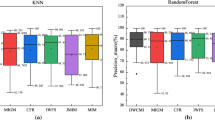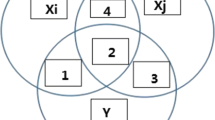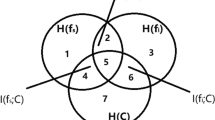Abstract
Many irrelevant and redundant features are commonly found in high-dimensional small sample data. Feature selection effectively solves high-dimensional minor sample problems by removing many irrelevant and redundant features and improving the algorithm's accuracy. In some information-theoretic-based feature selection algorithms, the problem is that choosing different parameters means choosing different feature selection algorithms. How to dynamically circumvent the pre-determined a priori parameters become an urgent problem to be solved. The paper proposes a dynamic weighted conditional relevance dispersion and redundancy analysis (WRRFS) algorithm for feature selection. Firstly, the algorithm uses mutual information to calculate feature correlations and redundancy between features. Secondly, calculate the mean of the feature correlation terms, and the parameter weights of the conditional feature correlation terms are dynamically adjusted using the standard deviation. Finally, WRRFS is validated against other feature selection algorithms on three classifiers using 12 different datasets with classification accuracy metrics (f1_macro,f1_micro, and f1_weighted). The experimental results show that the WRRFS algorithm can improve the quality of feature subsets and increase classification accuracy.






Similar content being viewed by others
References
Sen L, Anjun Ma, Sen Y et al (2018) A review of matched-pairs feature selection methods for gene expression data analysis. Comput Struct Biotechnol J 16:88–97. https://doi.org/10.1016/j.csbj.2018.02.005
Sadat HE, Hossein MM (2019) Evolutionary feature subsets selection based on interaction information for high dimensional imbalanced data classification. Appl Soft Comput 82:105581. https://doi.org/10.1016/j.asoc.2019.105581
Muhammed A-E, Marco A, Mohamed R (2021) Classification of breast cancer using microarray gene expression data: a survey. J Biomed Inform 117:103764. https://doi.org/10.1016/j.jbi.2021.103764
Hambali MA, Oladele TO, Adewole KS (2020) Microarray cancer feature selection: Review, challenges and research directions. Int J Cogn Comput Eng 1:78–97. https://doi.org/10.1016/j.ijcce.2020.11.001
Kushal KG, Shemim B, Aritra S et al (2021) Theoretical and empirical analysis of filter ranking methods: experimental study on benchmark DNA microarray data. Expert Syst Appl 169:114485. https://doi.org/10.1016/j.eswa.2020.114485
Ali D, Abdelkamel T, Samy M et al (2021) Gene selection and classification of microarray data method based on mutual information and moth flame algorithm. Expert Syst Appl 166:114012. https://doi.org/10.1016/j.eswa.2020.114012
Yang Z, Chaobo Z, Yiwen Z et al (2020) A review of data mining technologies in building energy systems: load prediction, pattern identification, fault detection and diagnosis. Energy Built Environ 1(2):149–164. https://doi.org/10.1016/j.enbenv.2019.11.003
Heng L, Gregory D (2019) A semi-parallel framework for greedy information-theoretic feature selection. Inf Sci 492:13–28. https://doi.org/10.1016/j.ins.2019.03.075
Kumar PS, Bhushan MR, Kumar TA (2021) Machine learning based methods for software fault prediction: a survey. Expert Syst Appl 172:114595. https://doi.org/10.1016/j.eswa.2021.114595
Wang X, Liu J, Cheng Y et al (2019) Dual hypergraph regularized PCA for biclustering of tumor gene expression data. IEEE Trans Knowl Data Eng 31(12):2292–2303. https://doi.org/10.1109/TKDE.2018.2874881
Jie C, Jiawei L, Shulin W et al (2018) Feature selection in machine learning: a new perspective. Neurocomputing 300:70–79. https://doi.org/10.1016/j.neucom.2017.11.077
Liyang G, Weiguo W (2020) Relevance assignation feature selection method based on mutual information for machine learning. Knowl Based Syst 209:106439. https://doi.org/10.1016/j.knosys.2020.106439
Gavin B, Adam P, Ming-Jie Z et al (2012) Conditional likelihood maximisation: a unifying framework for information theoretic feature selection. J Mach Learn Res 13:27–66
Lee C-Y, Cai J-Y (2020) LASSO variable selection in data envelopment analysis with small datasets. Omega 91:102019. https://doi.org/10.1016/j.omega.2018.12.008
Divya J, Vijendra S (2018) Feature selection and classification systems for chronic disease prediction: a review. Egypt Inform J 19(3):179–189. https://doi.org/10.1016/j.eij.2018.03.002
Albashish D, Hammouri AI, Braik M et al (2021) Binary biogeography-based optimization based SVM-RFE for feature selection. Appl Soft Comput 101:107026. https://doi.org/10.1016/j.asoc.2020.107026
Hua Z, Zhou J, Hua Y et al (2020) Strong approximate Markov blanket and its application on filter-based feature selection. Appl Soft Comput 87:105957. https://doi.org/10.1016/j.asoc.2019.105957
Zhang P, Gao W (2020) Feature selection considering uncertainty change ratio of the class label. Appl Soft Comput 95:106537. https://doi.org/10.1016/j.asoc.2020.106537
Jun W, Jinmao W, Zhenglu Y et al (2017) Feature selection by maximizing independent classification information. IEEE Trans Knowl Data Eng 29(4):828–841. https://doi.org/10.1109/TKDE.2017.2650906
Salem OAM, Liu F, Chen Y-PP et al (2021) Feature selection and threshold method based on fuzzy joint mutual information. Int J Approx Reason 132:107–126. https://doi.org/10.1016/j.ijar.2021.01.003
Emrah H, Bing X, Mengjie Z (2018) Differential evolution for filter feature selection based on information theory and feature ranking. Knowl Based Syst 140:103–119. https://doi.org/10.1016/j.knosys.2017.10.028
Li Z (2021) A new feature selection using dynamic interaction. Pattern Anal Appl 24(1):203–215. https://doi.org/10.1007/s10044-020-00916-2
Xie J-Y, Wang M-Z, Zhou Y et al (2019) Differential expression gene selection algorithms for unbalanced gene datasets. Chin J Comput 42(06):1232–1251. https://doi.org/10.11897/SP.J.1016.2019.01232
Yang HH, Moody J (1999) Data visualization and feature selection: new algorithms for nonGaussian data. In: Proceedings of the 12th international conference on neural information processing systems. MIT Press, Denver, CO, pp 687–693
Gao W, Hu L, Zhang P et al (2018) Feature selection considering the composition of feature relevancy. Pattern Recognit Lett 112:70–74. https://doi.org/10.1016/j.patrec.2018.06.005
François F (2004) Fast binary feature selection with conditional mutual information. J Mach Learn Res 5:1531–1555
Mohamed B, Yulia H, Rossitza S (2015) Feature selection using Joint mutual information maximisation. Expert Syst Appl 42(22):8520–8532. https://doi.org/10.1016/j.eswa.2015.07.007
Lijun X, Guo J, Xiangyuan Gu (2019) Algorithm for selection of features based on dynamic weights using redundancy. J Xidian Univ 46(05):155–161. https://doi.org/10.19665/j.issn1001-2400.2019.05.022
Zhang P, Gao W, Hu J et al (2021) A conditional-weight joint relevance metric for feature relevancy term. Eng Appl Artif Intell 106:104481. https://doi.org/10.1016/j.engappai.2021.104481
Chen Z, Wu C, Zhang Y, Huang Z, Bin Ran MZ, Lyu N (2015) Feature selection with redundancy-complementariness dispersion. Knowl Based Syst 89:203–217. https://doi.org/10.1016/j.knosys.2015.07.004
Dina R, Abecasis GR, Glaser B et al (2010) Functional gene group analysis reveals a role of synaptic heterotrimeric g proteins in cognitive ability. Am J Hum Genet 86(2):113–125. https://doi.org/10.1016/j.ajhg.2009.12.006
Zhang L, Chen X (2021) Feature selection methods based on symmetric uncertainty coefficients and independent classification information. IEEE Access 9:13845–13856. https://doi.org/10.1109/access.2021.3049815
Lin X, Li C, Ren W et al (2019) A new feature selection method based on symmetrical uncertainty and interaction gain. Comput Biol Chem 83:107149. https://doi.org/10.1016/j.compbiolchem.2019.107149
Guanglu S, Jiabin Li, Jian D et al (2018) Feature selection for IoT based on maximal information coefficient. Futur Gener Comput Syst 89:606–616. https://doi.org/10.1016/j.future.2018.05.060
Lewis DD (1992) Feature selection and feature extraction for text categorization. In: Proceedings of the workshop on speech and natural language. Association for Computational Linguistics, Harriman, pp 212–217. https://doi.org/10.3115/1075527.1075574
Marko R-Š, Igor K (2003) Theoretical and empirical analysis of ReliefF and RReliefF. Mach Learn 53(1):23–69. https://doi.org/10.1023/A:1025667309714
Juanying X, Mingzhao W, Ying Z et al (2014) Several feature selection algorithms based on the discernibility of a feature subset and support vector machines. Chin J Comput 37(08):1704–1718
Hanchuan P, Fuhui L, Chris D (2005) Feature selection based on mutual information criteria of max-dependency, max-relevance, and min-redundancy. IEEE Trans Pattern Anal Mach Intell 27(8):1226–1238. https://doi.org/10.1109/TPAMI.2005.159
Battiti R (1994) Using mutual information for selecting features in supervised neural net learning. IEEE Trans Neural Netw 5(4):537–550. https://doi.org/10.1109/72.298224
Lin D, Tang X (2006) Conditional infomax learning: an integrated framework for feature extraction and fusion. In: Proceedings of the 9th European conference on computer vision—volume part I. Springer, Graz, pp 68–82. https://doi.org/10.1007/11744023_6
Gao W, Hu L, Zhang P et al (2018) Feature selection by integrating two groups of feature evaluation criteria. Expert Syst Appl 110:11–19. https://doi.org/10.1016/j.eswa.2018.05.029
Ping Z, Wanfu G, Guixia L (2018) Feature selection considering weighted relevancy. Appl Intell 48(12):4615–4625. https://doi.org/10.1007/s10489-018-1239-6
Gao W, Hu L, Zhang P (2018) Class-specific mutual information variation for feature selection. Pattern Recogn 79:328–339. https://doi.org/10.1016/j.patcog.2018.02.020
Gu X, Guo J, Xiao L, Li C (2022) Conditional mutual information-based feature selection algorithm for maximal relevance minimal redundancy. Appl Intell 52(2):1436–1447. https://doi.org/10.1007/s10489-021-02412-4
Hongqiang L, Mingxi W, Jiuqiang H et al (2017) A filter feature selection method based on the maximal information coefficient and gram-Schmidt orthogonalization for biomedical data mining. Comput Biol Med 89:264–274. https://doi.org/10.1016/j.compbiomed.2017.08.021
Gao W, Hu L, Zhang P (2020) Feature redundancy term variation for mutual information-based feature selection. Appl Intell 50(4):1272–1288. https://doi.org/10.1007/s10489-019-01597-z
Zhou H, Wang X, Zhang Y (2020) Feature selection based on weighted conditional mutual information. Appl Comput Inform. https://doi.org/10.1016/j.aci.2019.12.003
Zhou H, Wang X, Zhu R (2022) Feature selection based on mutual information with correlation coefficient. Appl Intell 52(5):5457–5474. https://doi.org/10.1007/s10489-021-02524-x
Liu Yi, Cao J-J, Diao X-C et al (2018) Survey on stability of feature selection. J Softw 29(09):2559–2579. https://doi.org/10.13328/j.cnki.jos.005394
Funding
This study was supported by Jiangsu University of Technology Doctoral Research Start-up Fund (Grant No. KYY19042).
Author information
Authors and Affiliations
Corresponding author
Additional information
Publisher's Note
Springer Nature remains neutral with regard to jurisdictional claims in published maps and institutional affiliations.
Rights and permissions
Springer Nature or its licensor (e.g. a society or other partner) holds exclusive rights to this article under a publishing agreement with the author(s) or other rightsholder(s); author self-archiving of the accepted manuscript version of this article is solely governed by the terms of such publishing agreement and applicable law.
About this article
Cite this article
Zhang, L. A Feature Selection Method Using Conditional Correlation Dispersion and Redundancy Analysis. Neural Process Lett 55, 7175–7209 (2023). https://doi.org/10.1007/s11063-023-11256-7
Accepted:
Published:
Issue Date:
DOI: https://doi.org/10.1007/s11063-023-11256-7




